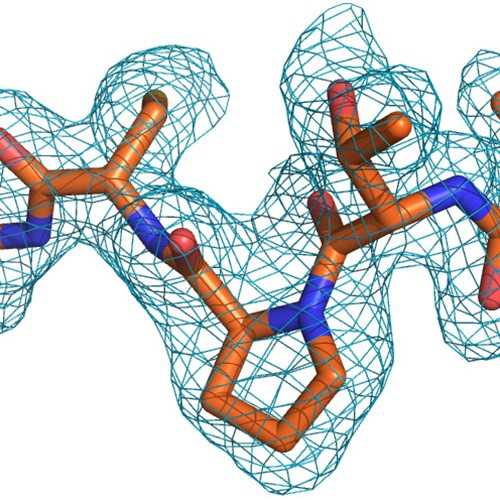Pre-Formed Fibrils, E46K α-Synuclein (α-syn-E46K PFFs)
Pre-formed fibrils (PFFs) of alpha-synuclein E46K variant.
Alpha-synuclein (α-synuclein) is an intrinsically disordered protein of unknown function that is linked to both familial and sporadic cases of Parkinson's disease, where it forms the major constituent of the pathological Lewy body aggregates. Certain cases of early-onset familial Parkinson's disease have been connected to the E46K α-synuclein variant; therefore, these fibrils can be used for disease modelling since PFFs have been shown to seed endogenous α-synuclein inclusions in healthy cells.
From the laboratory of Scott D. Ryan, PhD, University of Guelph.
Pre-formed fibrils (PFFs) of alpha-synuclein E46K variant.
Alpha-synuclein (α-synuclein) is an intrinsically disordered protein of unknown function that is linked to both familial and sporadic cases of Parkinson's disease, where it forms the major constituent of the pathological Lewy body aggregates. Certain cases of early-onset familial Parkinson's disease have been connected to the E46K α-synuclein variant; therefore, these fibrils can be used for disease modelling since PFFs have been shown to seed endogenous α-synuclein inclusions in healthy cells.
From the laboratory of Scott D. Ryan, PhD, University of Guelph.
| Product Type: | Protein |
| Name: | pre-formed fibrils (PFFs) of E46K alpha-synuclein |
| Alternative Name(s): | alpha-syn-E46K PFFs |
| Accession ID: | P37840 |
| Source: | Human, expressed in E. coli BL21 (DE3) CP+ |
| Amino Acid Sequence: | MDVFMKGLSKAKEGVVAAAEKTKQGVAEAAGKTKEGVLYVGSKTKKGVVHGVATVAEKTKEQVTNVGGAVVTGVTAVAQKTVEGAGSIAAATGFVKKDQLGKNEEGAPQEGILEDMPVDPDNEAYEMPSEEGYQDYEPEA |
| Fusion Tag(s): | None |
| Purity: | >95 %, purified by ion-exchange chromatography followed by reverse phase chromatography |
| Buffer: | Dulbeccos Phosphate Buffered Saline, Sigma D8537 |
| Comments: | A sedimentation assay was completed to confirm PFF formation |
| Storage: | -80C |
| Shipped: | Dry Ice |
Preparing PFFs (Pre-Formed Fibrils) for Treatment of Primary Neurons
SAFETY: Wear gloves, disposable sleeves, and a second pair of gloves when handling PFFs. Dispose of pipette tips and microfuge tubes in a container of 1% SDS. Wear protective headphones while sonicating fibrils, and decontaminate probe and spills with 1% SDS.
Preparation:
- Obtain stock PFFs from -80 freezer (stocks contain 10uL of 5mg/mL fibrils, and contain either WT or mutant α-synuclein; WT is used for most applications).
- Place PBS, 1% SDS and a P1000 in TC hood. Don sleeves and second pair of gloves.
- Pipette PBS into PFF aliquot depending on desired concentration (commonly 490uL is added to give a concentration of 0.1mg/mL) and place used tip in SDS.
- Remove outer gloves when leaving hood.
Sonication:
- Attach 1/8Ó microtip to sonicator (if not previously attached) and use wrench to tighten
- Clean the probe and the door of the enclosure with 70% EtOH.
- Set the sonicator to the following settings: 20% amplitude; 30 seconds; 1 second on, 1 second off
- Don a second pair of gloves.
- Place fibril tube in a tube rack in the sonicator enclosure
- Adjust the stand height such that the probe tip is submerged in the solution (about halfway between the solution surface and tube bottom), and adjust the rack so that the probe is in the middle of the tube.
- Remover outer gloves, close enclosure, don protective headphones, make sure Do Not Enter sign is on door, and press start.
- If bubbles form or the probe loosens during sonication, stop the sonication, don a second pair of gloves, and adjust as necessary.
- After sonication, don a second pair of gloves, remove and close the PFF tube, which is now ready for use.
- Clean the probe and anything the PFFs touched with 1% SDS. Clean again with 70% EtOH.
In cell culture, these sonicated PFFs are typically used at 1% vol/vol (or 10uL/mL of media).
- Ryan, T., Bamm, V.V., Stykel, M.G., Coackley, C.L., Humphries, K.M., Jamieson-Williams, R., Ambasudhan, R., Mosser, D.D., Lipton, S.A., Harauz, G., et al. (2018). Cardiolipin exposure on the outer mitochondrial membrane modulates α-synuclein. Nat. Commun 9, 1-17. doi:10.1038/s41467-018-03241-9.
- Stykel, M.G., Humphries, K., Kirby, M.P., Czaniecki, C., Wang, T., Ryan, T., Bamm, V., Ryan, S.D. (2018). Nitration of microtubules blocks axonal mitochondrial transport in a human pluripotent stem cell model of Parkinsons disease. Faseb. J 32, 5350-5364. doi:10.1096/fj.201700759RR.
If you publish research with this product, please let us know so we can cite your paper.


